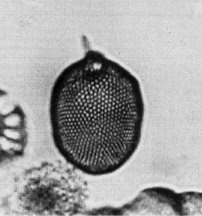 Lithopera
(Lithopera) bacca Ehrenberg
Lithopera
(Lithopera) bacca Ehrenberg Lithopera
(Lithopera) bacca Ehrenberg
Lithopera
(Lithopera) bacca EhrenbergLithopera bacca Ehrenberg, 1872a, p.314; 1872b, pl.8, fig.1; Nigrini, 1967, p.54, pl.6, fig.2 (with synonymy); Sanfilippo and Riedel, 1970, p.455, pl.1, fig.29
Cephalis simple, spherical, thick-walled, surface rough with small subcircular pores; half to two-thirds of cephalis depressed into thorax. Apical horn cylindrical, needle-like, less than or equal to length of cephalis; apical spine free. Dorsal and primary lateral spines extend beyond collar structure. In the region of the collar structure they lie entirely within the thoracic cavity, but very often become incorporated distally into the thoracic wall and may even project beyond it to form small wings about a third of the way down the thorax. Rarely, one of these spines forks within the thoracic cavity.
Thorax rather thick-walled, rough, ellipsoidal to subspherical, closed distally. Thoracic pores small, circular to subcircular, sometimes hexagonally framed, arranged in transverse rows (Nigrini, 1967).
Total length (excluding apical horn) 119-136 µm. Diameter of cephalis 18-27 µm. Length of thorax 100-128 µm; breadth 90-109 µm (Nigrini, 1967).
Total length 100-150 µm; maximum breadth 100-140 µm (Sanfilippo et al., 1985).
Closed postcephalic segment smoothly ellipsoidal, with numerous circular pores very regularly arranged in diagonal intersecting rows (Riedel and Sanfilippo, 1978a).
This species differs from L. neotera by the smoothness of its shape and regularity of its pore pattern (Sanfilippo et al., 1985).
The cephalis is half-buried in a closed spherical to ellipsoidal thorax with numerous circular pores very regularly arranged in diagonal intersecting rows. Most specimens are perfectly smooth in outline, and the pore arrangement is so regular that a small change in focus produces a characteristic optical interference pattern. Some specimens have an irregularity in the shell wall, where the pore pattern is interrupted, but the major part of the shell is always regular (Sanfilippo et al., 1985).
L. bacca is found in all middle late Miocene to Quaternary assemblages from latitudes lower than 40°. Its evolutionary transition from Lithopera neotera lies within the Diartus petterssoni Zone. It is extant.
L. bacca is an extant species that evolved from L. neotera.
Additional illustrations can be found in Riedel and Sanfilippo, 1971, pl.1F, figs.11-13; 1978a, pl.6, fig.9.
For further taxonomic discussion, see Nigrini (1967) and Sanfilippo and Riedel (1970).